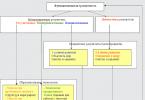This reference guide contains superimposed in a concise and accessible form the main material of the school chemistry course: general chemistry, inorganic chemistry, organic chemistry. The manual is designed in the form of tables and diagrams. Recommended for schoolchildren, applicants and school teachers.
Periodic law.
Properties chemical elements, as well as the forms and properties of compounds of elements are in a periodic dependence on the charge of the nuclei of their atoms.
1. The serial number of the element is equal to the charge of the nucleus and the number of electrons.
2. Period number - the number of levels.
3. Group number - valency (maximum positive oxidation state).
4. The metallic properties of the elements increase from top to bottom and from right to left. These properties are exhibited by elements with a small number of valence electrons.
GENERAL CHEMISTRY
Basic concepts and laws of chemistry.
Atomic-molecular doctrine.
Moth. Molar mass substances.
Chemical reactions.,
The law of conservation of mass of matter.
The law of the constancy of the composition of matter.
gas laws.
Periodic law of D.I. Mendeleev.
The structure of the atom.
Model of the state of an electron in an atom.
Periodic law.
Chemical bond.
covalent bond.
Ionic bond.
polar molecules. non-polar molecules.
Metal connection.
Hydrogen bond.
Crystal cell. Types of crystal lattices.
Structural formulas.
The degree of oxidation.
Valence.
Speed chemical reactions, chemical equilibrium.
Activation energy.
The concept of catalysis and catalysts.
Reversible and irreversible reactions.
chemical balance. Le Chatelier's principle.
Solutions. Theory electrolytic dissociation.
Numerical expression of the composition of solutions.
Solubility of substances in water.
Thermal phenomena during dissolution.
Electrolytes and non-electrolytes.
Theory of electrolytic dissociation. Mechanism.
Dissociation of acids, bases and salts in aqueous solutions.
Degree of dissociation. Ion exchange reactions.
dissociation of water.
The most important classes of inorganic compounds.
Oxides.
Acids.
Hydroxides.
Salt.
Redox reactions.
Theory of redox reactions.
Drawing up equations of redox reactions.
Influence of the environment on the nature of the reactions.
Classification.
Electrolysis.
INORGANIC CHEMISTRY.
Hydrogen.
Hydrogen compounds.
alkali metals. I group. Main subgroup.
alkaline earth metals. IIA group. (Calcium).
Group III A elements (Aluminum).
Group IV A elements (Carbon, silicon).
Elements of the UA group (nitrogen, phosphorus).
Group VIA elements. Chalcogens (oxygen, sulfur).
Elements of group VIIA. Halogens (Chlorine).
Elements of secondary subgroups.
Chromium subgroup.
subgroup of iron.
ORGANIC CHEMISTRY.
Hydrocarbons.
Limit hydrocarbons.
unsaturated hydrocarbons.
aromatic hydrocarbons.
Oxygen-containing organic compounds.
Alcohols.
Phenols.
Aldehydes.g.
Polycondensation.
Ketones.
carboxylic acids.
Complex ethers.
Nitrogen-containing organic compounds.
Amines.
Aniline.
Amino acids.
Squirrels.
Free download e-book in a convenient format, watch and read:
Download the book Chemistry in tables and diagrams, Kurmasheva KK, 2002 - fileskachat.com, fast and free download.
- Cool self-instruction manual of English for beginners and beginners, Dragunkin A.N., 2002 - Today, an event has occurred that, apparently, after some time will also be called a milestone, “civilizational”. This event is… English language books
- New reference book for chemist and technologist, Basic properties of inorganic, organic and organoelement compounds, 2002
The tutorial outlines theoretical basis organic chemistry. The structure, physical and Chemical properties, production methods and areas of application of saturated, unsaturated, diene and aromatic hydrocarbons, all oxygen-containing organic compounds, amines, aniline, amino acids, amides carboxylic acids and nitro compounds. given a brief description of proteins, peptides and heterocyclic compounds. Described nucleic acids, their composition and types, hydrolysis and structure. The types of polymeric materials, their structure, main technical properties and fields of application are considered. Organic compounds and chemical processes in living organisms. A feature of the manual is a visual representation of most of the material in the form of diagrams, tables, formulas, which contributes to a better assimilation of the course.
Step 1. Choose books in the catalog and click the "Buy" button;
Step 2. Go to the "Basket" section;
Step 3. Specify required amount, fill in the data in the Recipient and Delivery blocks;
Step 4. Click the "Proceed to payment" button.
At the moment, purchase printed books, electronic access or books as a gift to the library on the EBS website is possible only with 100% advance payment. After payment, you will be given access to the full text of the textbook within Electronic Library or we start preparing an order for you at the printing house.
Attention! Please do not change the payment method for orders. If you have already chosen a payment method and failed to complete the payment, you need to re-register the order and pay for it in another convenient way.
You can pay for your order using one of the following methods:
- Cashless way:
- Bank card: you must fill in all fields of the form. Some banks ask you to confirm the payment - for this, an SMS code will be sent to your phone number.
- Online banking: banks cooperating with the payment service will offer their own form to fill out. Please enter the correct data in all fields.
For example, for " class="text-primary">Sberbank Online mobile phone number and email required. For " class="text-primary">Alpha Bank you will need a login in the Alfa-Click service and email. - Electronic wallet: if you have a Yandex wallet or Qiwi Wallet, you can pay for the order through them. To do this, select the appropriate payment method and fill in the proposed fields, then the system will redirect you to the page to confirm the invoice.
State budgetary educational institution higher professional education
"Pyatigorsk State Pharmaceutical Academy"
Ministry of Health and Social Development of the Russian Federation
ORGANIC CHEMISTRY
SCHEMES AND DRAWINGS
Textbook for 2nd year students (3, 4 semesters)
(full-time education) for students of 2 and 3 courses ( absentee form training)
in discipline C2.B.7 - "Organic Chemistry"
Pyatigorsk, 2011
UDC. 547(076)
Printed by decision of the CMS of the Pyatigorsk State Pharmaceutical Academy. Minutes No. 7 dated April 2, 2003
General edition: Head. Department, Professor Oganesyan E.T.
But on the basis of the current program in organic chemistry for pharmaceutical universities, a manual has been created that allows in a concise and accessible form to obtain information about the structure, methods of obtaining and reactivity the most important classes of organic compounds.
Reviewers: Professor Kompantsev V.A., Associate Professor Saushkina A.S.
Editorial Council:
Belikov V.G. (responsible editor) – prof. Ph.D.; Vergeichik E.N. (deputy editor) - prof., Ph.D.; Pogorelov V.I. (deputy editor) - prof., Ph.D.; Muravieva D.A. – Prof., Ph.D.; Gaevy M.D. – Prof., MD; Gatsan V.V. – Prof., Ph.D.
Karpova V.V.; Bratashova T.M. (responsible secretary)
1.1 Classification and main varieties of nomenclature
1.3 Substitutive nomenclature of functional derivatives
2.2 sp 3 -Hybridization. The structure of alkanes. Forecasting
2.3 Structure of cycloalkanes. reactionary forecasting
2.4 sp 2 -Hybridization. The structure of ethylene. Forecasting
2.5 The structure of butadiene-1,3. The concept of conjugation. Influence
2.7 sp hybridization. The structure of acetylene and the reaction
ability of alkynes .............................................................. ............................................... | |||
Electronic structure of heterocyclic compounds. | |||
Prediction of reactivity based on structure analysis .............................. | |||
Features of the structure of the sp2 -hybrid nitrogen atom .............................................. | |||
Electronic structure of pyridine ............................................................... .................... | |||
Electronic structure of pyrrole ............................................................... ...................... | |||
Electronic structure of pyrazole .............................................................. .................... | |||
Isomerism of organic compounds ............................................................... ......................... | |||
Types of isomerism .................................................. ................................................ | |||
Properties of chiral compounds ............................................................... ................... | |||
Rules for working with Fisher's projection formulas............................................... | |||
Stereochemical nomenclature .................................................................. ............................... | |||
D-, L-notation system .............................................. ................................. | |||
R-,S-notation system .............................................. ................................. | |||
Classification and mechanisms of organic reactions .............................................. | |||
Classification of reactions .................................................................. ................................. | |||
Mechanism of radical substitution reactions (SR) .............................................. | |||
Mechanism of electrophilic substitution reactions (SE) .................................................. | |||
The reaction mechanism of nucleophilic substitution (SN) at | |||
sp3 -hybrid carbon atom .............................................. ................................. | |||
Mechanism of electrophilic addition reactions (AdE ) .................................. | |||
Mechanism of nucleophilic addition reactions (AdN) .............................................. | |||
Reactivity and methods for obtaining organic substances in | |||
diagrams ................................................. ................................................. ......................... | |||
FOREWORD
The study of organic chemistry in pharmaceutical higher education educational institutions sets as its most important goal the formation in students of a methodical approach to the study of the relationship between the structure of molecules and their properties.
The abundance of theoretical material creates the prerequisites for achieving this goal, however, students often experience an urgent need for such a source of information that would allow them to quickly and easily answer many questions related to the study of methods for obtaining and reactivity of organic compounds.
The present tutorial it is designed to help students in a concise and accessible form to obtain information,
concerning the structure and properties of the most important classes of organic compounds.
1. BASES OF CLASSIFICATION AND NOMENCLATURE OF ORGANIC COMPOUNDS
1.1 Classification and main varieties of the nomenclature of organic compounds
Organic chemistry is the chemistry of hydrocarbons and their derivatives. Several million organic compounds are now known. To study such a huge number of substances, they are divided into smaller groups - classes, within which the compounds have similarities in structure, and hence in chemical properties.
classify organic matter can be according to various criteria: I - according to the structure of the carbon chain, they can be a) acyclic (ug-
ice chains do not have cycles); b) cyclic (carbon chains are closed in cycles);
II - according to the nature of carbon-carbon bonds, substances are divided into a) limiting (in molecules there are only single carbon-carbon bonds); b) unsaturated (molecules have double or triple carbon-carbon bonds); c) aromatic (cyclic compounds with a special type of bond (see.
III - subject to availability functional groups substances belong to different classes (the most important are presented in Table 1).
Nomenclature is a set of rules that allows you to give a name to each chemical compound. Highest value has a replacement nomenclature; for derivatives of hydrocarbons, in addition to the substitutional one, the radical-functional nomenclature is often used. For some compounds, trivial (historically established) names are used.
1.2 Substitutive hydrocarbon nomenclature
Hydrocarbons are substances whose molecules consist only of carbon and hydrogen atoms.
To give a name to an acyclic hydrocarbon according to substitutional nomenclature, one must:
one . Select the parent structure using the following order:
1) the maximum number of multiple (double, triple) bonds;
2) maximum chain length;
3) the maximum number of substituents (radicals).
2* . Number the parent structure so that smallest values(locants) received:
1) multiple bonds;
2) hydrocarbon substituents.
Each subsequent item is valid in the absence of the previous one, or if the previous one did not give an unambiguous answer.
3 . Name all radicals (see Table 2)
4. Compose a name according to the following scheme:
Console | The ending | ||||||||||||||||||||||||||||||||||||||
Hydrocarbon | An - alkanes | ||||||||||||||||||||||||||||||||||||||
deputies | hydrocarbon | En - alkenes | indicating |
||||||||||||||||||||||||||||||||||||
alphabetically | chain (ancestor- | Yn - alkynes | provisions |
||||||||||||||||||||||||||||||||||||
structure) | Diene - alkadienes | multiple bonds |
|||||||||||||||||||||||||||||||||||||
For example: | |||||||||||||||||||||||||||||||||||||||
3-ethylhexane | |||||||||||||||||||||||||||||||||||||||
C2 H5 | |||||||||||||||||||||||||||||||||||||||
3-methyl-3-ethylpentene-1 | |||||||||||||||||||||||||||||||||||||||
CH3 2 | |||||||||||||||||||||||||||||||||||||||
(CH2) | |||||||||||||||||||||||||||||||||||||||
C3 H7 CH3 | |||||||||||||||||||||||||||||||||||||||
3,3,4-trimethyl-4-propylnonin-1 | |||||||||||||||||||||||||||||||||||||||
2-isopropylbutadiene-1,3 or 2-(1-methylethyl)butadiene-1,3 |
|||||||||||||||||||||||||||||||||||||||
Table 1 | |||||||||||||||||||||||||||||||||||||||


table 2 |
|||||||
Names of some hydrocarbon substituents |
|||||||
Titles |
|||||||
trivial | systematic |
||||||
permissible | |||||||
CH3- | |||||||
(CH-) | |||||||
isopropyl | 1-methylethyl |
||||||
CH3-CH2-CH2-CH2- | |||||||
CH CH2 | isobutyl | 2-methylpropyl |
|||||
sec-butyl | 1-methylpropyl |
||||||
tert-butyl | 1,1-dimethylethyl |
||||||
II Alkenyls | |||||||
CH2- | propen-2-yl |
||||||
III alkynyls | |||||||
not used | |||||||
CH2 - | not used | propyn-2-yl |
|||||
(C6 H5-) | |||||||
2-methylphenyl |
|||||||
phenylmethyl |
|||||||
2-phenylethenyl |
|||||||

For cyclic hydrocarbons, either the cycle or the acyclic hydrocarbon chain associated with the cycle is chosen as the parent structure. The numbering of the cycle in the case of the presence of substituents is carried out from one substituent to another so that the locants receive the smallest value.
CH2-CH2-CH3 | CH C2 H5 |
|||||||||||||
sec-butylbenzene |
||||||||||||||
1-methyl-2-propylcyclopentane |
||||||||||||||
For some cyclic hydrocarbons, IUPAC rules allow the following trivial names:
CCH3 |
|||||||||
ortho-xylene | meta-xylene | ||||||||
para-xylene | |||||||||
naphthalene | |||||||||
anthracene | |||||||||
phenanthrene |
|||||||||
H3 C C CH3 | |||||||||

1.3 Substitutive nomenclature for functional derivatives of hydrocarbons
Functional groups (F.G.) - groups of non-carbon atoms |
||||||
nature, replacing hydrogen atoms in the hydrocarbon chain and |
||||||
defining properties (function) of compounds. | ||||||
The most important functional groups are: | ||||||
Table 3 |
||||||
Name | Name | Name |
||||
hydroxy- | ||||||
SO3 H | ||||||
carbonyl- | ||||||
alkylthio- |
||||||
carboxyl- | ||||||
carbamoyl- | ||||||
carbonyl- | ||||||
According to the nature and quantity of PG, organic compounds are divided into the following |
||||||
common groups: | ||||||
Functional derivatives of hydrocarbons
Monofunctional | Polyfunctional | Heterofunctional |
|||||||||||||||||||||
identical F.G.) | |||||||||||||||||||||||
To give a name to the functional derivatives of hydrocarbons, it is necessary: 1. Choose the parent structure - a hydrocarbon chain linked:
1) with a functional group (for monofunctional compounds);
2) With a large number functional groups (for polyfunctional compounds);




